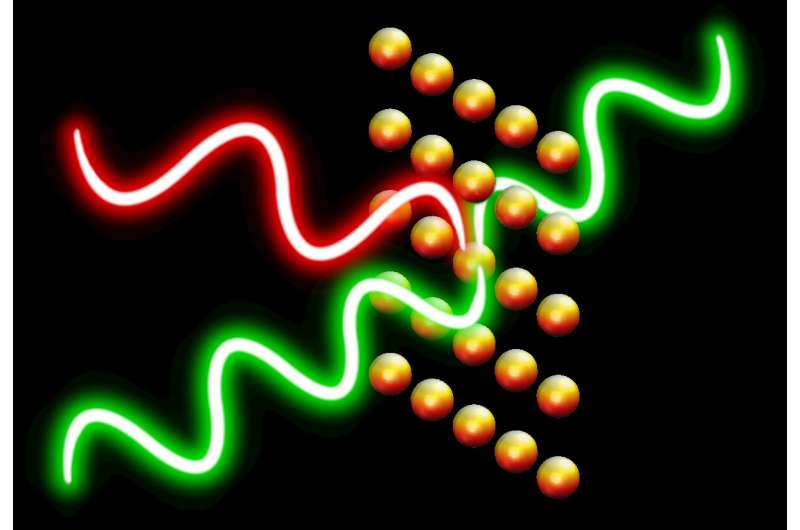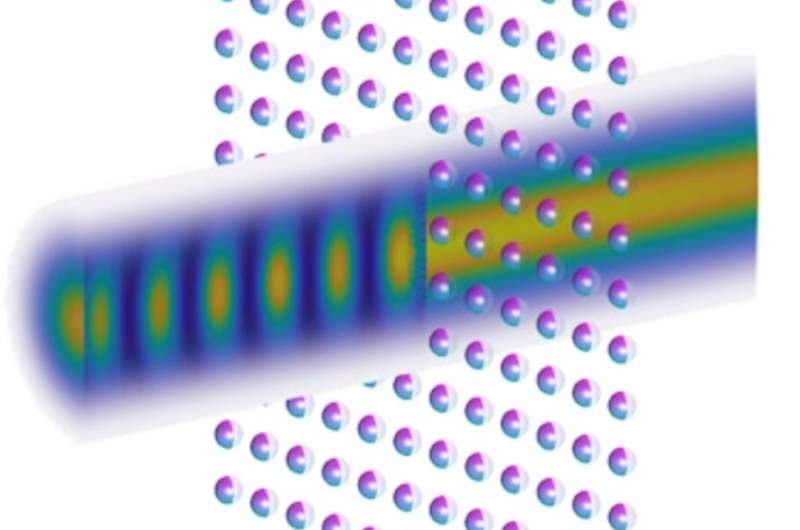April 15, 2020 feature
A quantum metasurface that can simultaneously control multiple properties of light

Metasurfaces are artificial materials designed at the nanoscale, which can control the scattering of light with exceptionally high precision. Over the past decade or so, these materials have been used to create a variety of technological tools ranging from sensors to lenses and imaging techniques.
A research team led by Mikhail Lukin at Harvard University has recently proposed a new type of metasurface that can control both the spatiotemporal and quantum properties of transmitted and reflected light. In a paper published in Nature Physics, the team showed that realizing a quantum metasurface is possible and could be achieved by entangling the macroscopic response of thin atom arrays to light.
"Quantum metasurfaces are an entirely new type of materials designed atom by atom, which enable applications such as quantum computation with photons," Rivka Bekenstein, the lead author of the recent paper, told Phys.org. "We combined a state-of-the-art technique for manipulating the state of many atoms by long-range interactions (i.e., Rydberg interactions) with a recent discovery of how a single sheet of atoms can reflect light. We identified an architecture that can be realized in the laboratory, in which a single layer of atoms can act as a switchable quantum mirror."
As part of their study, Bekenstein and her colleagues reviewed different quantum metasurfaces that can be controlled to have different light scattering properties. One of the most prominent sources for the development of quantum technologies are entangled states, which are unique states that only exist for quantum entities. The quantum metamaterial proposed by the researchers enables the production of specific entangled states of many light particles (i.e., photons), which are particularly valuable for quantum information processing applications.
In certain environmental conditions, atoms can be manipulated to become transparent using external electrical fields. Recent studies have also demonstrated that a single sheet of atoms can reflect light, resembling a regular mirror.
By employing Rydberg interactions that naturally occur in atomic systems, Bekenstein and her colleagues were able to identify a scheme in which a single layer of atoms simultaneously reflects and transmits light in a quantum superposition. In other words, the resulting quantum metasurface could both become transparent and reflect light, like a mirror.

"In quantum mechanics, entities can co-exist in different states—this is called a superposition state," Bekenstein said. "Our quantum metasurface is a new type of material that can make light co-exist in two different directions. This is done by manipulating the atoms' state and then shining a weak laser to scatter from them."
The design strategy employed by Bekenstein and her colleagues induces quantum entanglement between different metasurfaces and light, as well as between individual light particles. Notably, the architecture they proposed could also be manipulated to have varying amounts of photons in entangled states, which is a crucial capability for most quantum applications, including quantum computing.
Through a series of quantitative calculations, the researchers analyzed how their metasurface enables quantum operations between atoms and photons, allowing for the generation of highly entangled photonic states that are ideal for quantum information processing applications.
"A key advantage of our architecture is that only one atom has to be prepared in a quantum superposition state in the laboratory," Bekenstein said. "Hundreds of atoms construct the quantum metasurface, but only one has to be manipulated on the quantum mechanical level, which make this proposal practical. This is enabled due to the long-range interaction we utilize in the scheme, which naturally exists for atoms in specific energy levels."
Remarkably, the recent study by Bekenstein and her colleagues introduces a technique to gain quantum control over the response of macroscopic materials to light. This technique could pave the way for the development of an entirely new type of quantum materials, while also potentially revolutionizing the current understanding of quantum optical materials and their response to light.
"We are currently exploring additional experimental systems that can realize the quantum metasurfaces we proposed," Bekenstein said. "We are also interested in revealing the nonlinear response of these quantum metasurfaces to light, which occur for higher intensity light beams. Finally, we are investigating specific practical applications of the proposed quantum metasurfaces for quantum information processing."
More information: R. Bekenstein et al. Quantum metasurfaces with atom arrays, Nature Physics (2020). DOI: 10.1038/s41567-020-0845-5
Journal information: Nature Physics
© 2020 Science X Network




















